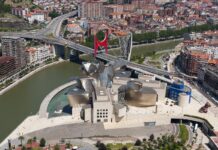We’ve been finding myriad articles from all over the world about the 25th anniversary of the opening of the Bilbao Guggenheim Museum.
It’s quite clear that this was a perfect opportunity for many media outlets to remember the history of this Basque institution and the local and wider impact it’s had.
We’ve written a lot about this museum and its links to the urban transformation process the Bilbao metro area has undergone, sometimes to highlight how the articles’ authors have understood this process and the role the transformation’s most emblematic element, the Museum, has played therein.
Other times, many other times, we did so to recall how other articles’ authors stated that the urban transformation of the Bilbao metro area did not depend on the museum, nor was it the cause or driving force behind that transformation.
The Museum was a huge wager, against the opinion of many, by a group of visionaries who were the driving force behind the metamorphosis in this part of our country and who understood that its construction and opening would truly increase our country’s international reach and improve its image abroad. And so it did, to a degree that neither its promoters, nor those of us here at the blog (firm defenders of the project), could have ever dared imagine. Though, we must also say, when we saw CNN covering the opening from Bilbao on October 18, 1997, we began to get an idea of what this building would mean for the present and future of our society.
Against those who at first were against it, who then went on to deride its success as a passing fad, 25 years later, the Museum has become a worldwide role model. As we explained six years ago: it was neither a “folly” or a “perishable product.”
As we stated then:
Today, we Basques can say that we’ve achieved the impossible. We’ve “stolen” a Big Apple icon from New Yorkers. In 1995, whenever anyone heard “Guggenheim”, they thought of the fascinating building designed by Frank Lloyd Wright on Fifth Avenue. Today, however, the word “Guggenheim” more often elicits memories of the Frank Gehry masterpiece in Bilbao.
And for those who bet against it, who wagered it would fail spectacularly, this has been quite exasperating. They wasted no opportunities to try to undermine the museum and downplay its importance.
Out of all the articles we’ve received, we’ve decided to choose two due to their better, more accurate, vision of what the Museum means. One, by William Cook, was published in the Independent; the other, by Sam Jones, in The Guardian. Coincidentally, both are British papers.
William Cook, in his article in the Independent, analyzes the Museum’s 25 years from a perspective that has become a byword in British politics: “leveling up.” His breakdown is quite interesting.
Regarding how the Museum has reached elite status on the international stage “to stay,” despite the opposition of so many, can be summed up in this one line:
One of the world’s most iconic buildings like the Eiffel Tower. Yet, like the Eiffel Tower, its construction was extremely contentious – looking back, it seems remarkable that it was ever built at all.
It’s an interesting read that will undoubtedly help many people, abroad and here at home, to understand the reasons that led to the Museum’s construction and the consequences it’s had globally for the Basque Country.
By the way, in order to read the Independent article (highly recommended), you need to be subscribed (registration is easy and free, at least for now).
Sam Jones in The Guardian tries, and succeeds, to define the importance all this cultural infrastructure has had in the rebirth of the Bilbao metro area.
Perhaps the key summary of what the Museum and its famous “Guggenheim effect” are as regards the urban transformation of Bilbao can be found in the explanation given by Juan Ignacio Vidarte, a driving force behind the Museum project, and its brilliant and successful curator since its opening:
“If people use the phrase ‘Guggenheim effect’ to communicate the idea that cultural infrastructure can have a transformative effect that goes beyond the purely cultural sphere – that it can have a social, architectural, planning and economic impact – then I’d go along with that.
But they need to understand what all that involves. I don’t like it when that phrase is associated with projects that have nothing in common with this one besides a spectacular building, or with grabby projects. It’s about having the other ingredients that are fundamental to understanding why it worked here but hasn’t worked in many other places.
This project was part of a much bigger plan and it fitted in with that plan and didn’t happen in isolation.”
Two brilliant takes on what the Bilbao Guggenheim Museum is and has meant from two British papers. We wish all journalists were as capable of understanding things as these two journalists are. Unfortunately, many have fallen into the “cut and paste” style of using very abundant, but incorrect, opinions and continue giving the overly simplistic overview of what the Museum is and why and how it has been so successful.
But we’re not going to talk about that today.
So, to finish,
Zorionak Guggenheim Bilbao
Independent – 6/11/2022 – Great Britain
Can Bilbao’s Guggenheim provide a model of art-led levelling up?
Outside Bilbao’s Guggenheim Museum, beside the Río Nervión, stand two sculptures by Eduardo Chillida, the Basque Country’s greatest modern artist, which symbolise the rejuvenation of this gutsy Spanish port. These robust iron monoliths reflect Bilbao’s rustbelt origins, a city built on shipbuilding and steelmaking, and its dramatic shift to service industries, clean energy and research.
(Follow)
The Independent does not accept automatic translation; you’ll have to copy and paste it into Google Translate
The Guardian – 31/10/2022 – Great Britain
Guggenheim effect: how the museum helped transform Bilbao
Evening approaches Bilbao’s old port, bringing with it the joggers who pinball along the promenades, the tourists mulling a cruise on the dark green waters of the estuary, and the woman in the artisan ice-cream booth who keeps vigil behind tubs of dulce de leche, passionfruit and bubblegum-flavoured “blue smurf”.
(Follow) (Automatic translation)
Foto cabecera: Museo Guggenheim Desde La Salve – Foto Museo Guggenheim Bilbao
Last Updated on Nov 13, 2022 by About Basque Country
































